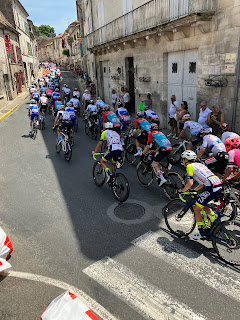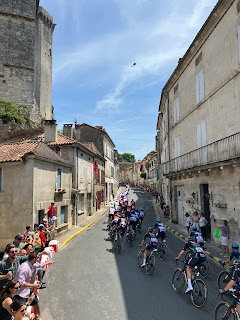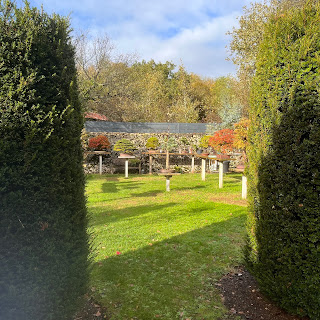It never takes long for visiting friends to ask a worried question - “This place is gorgeous, but what do you do for entertainment around here?” They’ve arrived from the real world where there is a convenience store on every corner, 24 hour grocery stores, restaurants that cater to the clients whims, and miles and miles of suburbia. Visitors are startled by the quiet that goes on forever here. They can’t imagine what unexpected and quirky events are out there just waiting to be experienced.
The most obvious ‘event’ is the simple activity of living in the midst of history. Everyday we go about our everyday life in a movie set: castles, shopping at village markets and boutiques hidden along Renaissance streets, wine tastings, hikes along ancient pathways, warm baguettes on the corner.
There are annual events noted on the calendar. Garden fairs in spectacular village settings, antiques fairs in city squares, Christmas markets in medieval halls, and spring open house days to visit private gardens, mid-summer open house days to visit private castles.
But the extra spice added to our quiet life are the unexpected and often quirky local events. Here’s a few highlights from 2023:
In early spring we took a chance and attended a “local” opera production. We got a little bit dress up (opera is opera) and headed out with low expectations. We weren’t the only ones dressed up! Entering the concrete foyer we noted velvet coats and suit jackets, lipstick and silk scarves. Outside the weather was grey and wet, but inside there was a warm, happy buzz in the air. Once the lights went down and spotlights hit the stage we were lost in the land of Traviata. Turns out there is a treasure trove of hidden talent in the area and enough enthusiasm to attract professionals to raise the bar. An unexpected night at the opera that was not at all quirky - except for being in a concrete basketball arena.
In July THE Tour de France came whizzing right smack dab up the center of our small village! This had given us something to talk about for months and now the BIG day was here. We staked out the best viewing place, grabbed memorabilia from free swag tables and hung around for hours in anticipation of the riders. Then things started to happen. Swag trucks whipped through the village throwing out silly toys and snacks. Followed by zooming, honking security. The riders are coming! When the TV helicopters swooped and hovered overhead we knew the peloton was really close. Swish, the riders were sweeping past in a powerful gust of wind —and they were gone. Hours of waiting for seconds of thrill. A good time was had by all (even those cynics that thought it was pointless to sit around waiting and visiting for all those hours) were caught up by the unexpected and quirky energy surrounding 176 absolutely crazy professional bikers.

Then on a very hot August night there was another opera. This one was in the courtyard of our very own chateau. We reserved tickets (shockingly it was selling out), got a little bit dressed up and walked up through the village. The scene was set up under one of the tallest castle towers in France, swallows swooped over the stage and the audience sat nestled under the sun-kissed walls of the Renaissance chateau. There were four singers and one narrator. The singers were quite good. The narrator kept falling asleep. The magic of the evening was unexpected and the production just as quirky as expected.
As the season changed along with our wardrobes I headed into Perigueux for a fashion show. I’m not kidding. It was an honest to goodness beautifully presented fashion show. Three models sashayed to spunky music, an MC gave details of each outfit and dressed up women in the audience took notes on items that caught their eye. Who knew there were so many chic women hiding in our middle of nowhere. The evening was hot and the boutique doors were open. Light from the shop spilled out onto the sidewalk along with the hip swinging, sashaying music. A little girl drawn in by curiosity appeared in the rays of light, eventually she crept directly in the doorway, then she relaxed and sat down. She was entranced by the scene. I was entranced by this vignette of curiosity leading to bravery. It was a beautiful evening with unexpected glamor and a sweetly quirky childish, twist. (The little girl’s parents were just next door at an outdoor café.)
We were up bright and early the next morning and off to a World Cup Rugby match in Bordeaux - Fiji vs Georgia. We joined forty thousand large, t-shirted rugby fans streaming into the cathedral-like stadium. The stadium was a bonus architectural adventure, but there was more to come - there was the rugby - a first for us. The almost genteel ambiance of the eloquently designed stadium was quite unexpected and the game of rugby is insanely quirky.
The year is wrapping up in a blur of too much fun. I haven’t even mentioned the day trips to Paris to see art and soak up city noise and energy and day trips to Bordeaux for antique fairs, window shopping and wine tastings.
There are still a few weeks left in the year - I’m curious to see what unexpected, quirky events drop into our laps.





























































